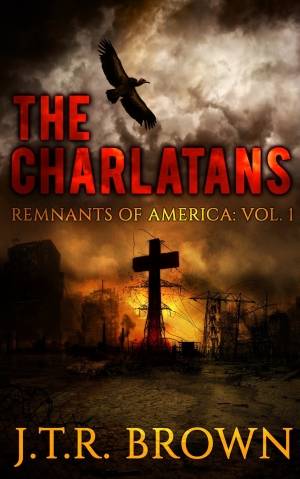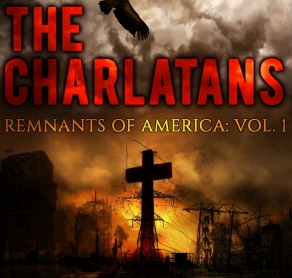There are concepts so grand in scope that, but for a miracle, the pursuit of them would always end in disaster. Such is the case with some elaborately estimated near-future incarnations of America after whatever apocalypse has befallen it, be it environmental, economic, or civil war. In the near future (2098, to be exact) of J.T.R. Brown‘s The Charlatans, Remnants of America: Volume I, the United States has broken into six independent countries. This particular narrative takes place in what we now know as the South, which in Brown’s future is the National Congregation of Theocratic Christianity. (This is exactly what it sounds like.)
There are many characters, but the book mostly follows Shuttlesworth and Claybrooke, two former psychiatrists now working for the church as exorcists. The NCTC has redefined Christianity, and has based their society on Old Testament portions of the Bible. The religious leaders use their positions to control the population, even going so far as to edit the “niceness” out of the Bible, keeping only the fire-and-brimstone bits.
Something to keep in mind, however, especially given the name of the book, is that Shuttlesworth and Claybrooke are, in fact, frauds.
From the author’s synopsis:
Shuttlesworth and Claybrooke are out-of-work psychiatrists who immigrated from the Northeast to make their fortunes in the Theocracy by pretending to be exorcists, secretly treating the “demon possessed” with black market psychotropic medications—for a hefty price.
Shuttlesworth, conflicted about swindling the Theocracy’s poverty-stricken citizens, stumbles upon an underground revolutionary group, Kingdom Come, and becomes fascinated by their charismatic leader Raziel. On the eve of the revolution, Shuttlesworth and Claybrooke arrive at an exorcism to find the last thing they expect—a real demon. The creature is hellbent on destroying Raziel and the Kingdom Come movement, and he intends to use the two conmen to do it. To defeat the demon, they’re both forced to attempt the riskiest cons of their lives—with an entire nation at stake.
One cannot argue that this is a dazzling concept for a novel, and one worthy of undertaking, by the writer and by the reader. And, while I’m impressed by the ideas put forth by the novel, I’m somewhat disappointed by the execution of the storytelling.

As someone with little knowledge of Christianity, I’m not sure I understood the nuances and intricacies of the National Congregation of Theocratic Christianity. I can say, though, that the government seems like any led by religious extremists. The religious Zealots in The Charlatans reminded me of the squads of men who would apprehend women during Iran’s 1979 revolution. In that way, it was very disturbing, because the worst-case scenario of Christianity has already been played out by other religions in modern history.
Maybe it’s because I’m a new mom filled with hope and possibility, or maybe it’s because religious extremism freaks me out; either way, this book was hard for me to read. I think Brown does such a good job describing the theoretical future country he has created that its plausibility is both impressive and severly depressing. It’s a bleak outlook for America.
Honestly, and though I hate admitting this, I didn’t want to finish it. The sense of dread permeating the pages was, to me, a little overwhelming. The more I read, the less I believed that the good guys were going to win. In this way, Brown’s writing was extremely effective (as well as affective), but it wasn’t what I’d call an enjoyable feeling. I love being drawn in by a book, and I was definitely drawn into this one; but being drawn in by The Charlatans made me feel weighed down and hopeless.
In addition, and there’s no getting around this, there were many points where it was obvious that this book had been self-published. It’s probably the English teacher in me, but I find typos and misspellings in published books absolutely unforgivable. To spend one’s time reading a published book rife with errors is terribly distracting.
Also, sorry to nit-pick, but I can’t help but feel that an editor would have discouraged naming a villain Sicarious. Seriously, Scare-ious? Appropriate for a Disney movie, but not a novel set after the destruction of a nation. There are also some strange inconsistencies: the citizens don’t know what photographs are, but are familiar with Polka?
This brings me to my biggest complaint about the novel: the narrator. This omniscient narrator is so very dry—Ben Stein dry—that I felt like I needed a vaporizer running while I read. There is a stilted quality to the writing that makes it oddly formal and a little stiff. However, I must acknowledge that others might disagree. To some, the backdrop, characters, and narrative might be right on the money, paranoia-inducing. The tone and narration might seem perfect to them; just not to me.
There’s no doubt that what Brown has undertaken in writing The Charlatans is incredibly ambitious. The amount of thought that went into the setting alone is worthy of acknowledgment and even praise. The scope of the plot and the level of detail Brown has included will likely amaze this novel’s readers. But he makes you work for it.
In summation, though it was clearly not my cup of tea, I cannot say that this book is without merit. If you are a fan of the current post-apocalypse/goverment-collapse genre, or if you enjoy the intricate worlds created in books by Neil Gaiman or even Christopher Moore, consider giving The Charlatans a try.








